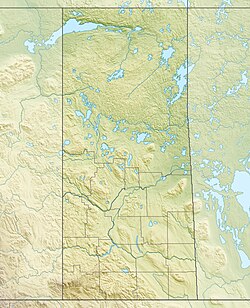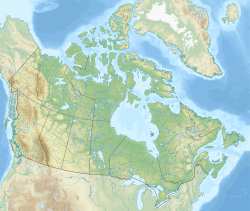Sturgeon-Weir River
| Sturgeon-Weir River Riviere Maligne | |
|---|---|
 A canoe navigating the rapids on the Sturgeon-Weir River | |
 Map of the Saskatchewan River drainage basin | |
| Location | |
| Country | Canada |
| Province | Saskatchewan |
| Physical characteristics | |
| Source | Corneille Lake |
| • location | Northern Saskatchewan Administration District |
| • coordinates | 55°01′3″N 102°38′9″W / 55.01750°N 102.63583°W |
| • elevation | 311 m (1,020 ft) |
| Mouth | Namew Lake |
• coordinates | 54°16′23″N 101°49′01″W / 54.27306°N 101.81694°W[1] |
• elevation | 266 m (873 ft) |
| Length | 131 km (81 mi) |
| Basin features | |
| River system | Nelson River |
| Tributaries | |
| • left | Goose River |
| [2] | |
Sturgeon-Weir River is a river in east-central Saskatchewan, Canada.[1] It flows about 130 kilometres (81 mi) south-southeast to join the Saskatchewan River at Cumberland House, Saskatchewan. It was on the main voyageur route from eastern Canada northeast to the Mackenzie River basin. The river is a popular wilderness canoe route in Canada.[3]
Description
[edit]The river's source is Corneille Lake, near the community of Pelican Narrows. It travels south-east, crossing Highway 106 before reaching Amisk Lake. It then continues south-easterly to Sturgeon Landing and Namew Lake. It runs through the Churchill River Uplands ecoregion which is located along the southern edge of the Precambrian Shield. The area contains continuous coniferous and boreal forest, consisting of closed stands of black spruce and jack pine and a ground cover of mosses and lichens. Local relief rarely exceeds 25 metres (82 ft), but there are ridged steeply sloping rocky uplands and lowlands with exposed bedrock throughout. Wildlife includes barren-ground caribou, moose, black bear, lynx, wolf, beaver, muskrat, red-backed vole, and snowshoe hare. Bird species include raven, common loon, spruce grouse, bald eagle, Canada jay, hawk-owl, and waterfowl, including ducks and geese. Trapping, hunting, fishing, and tourism are occasional uses of land in this region.[4]
History
[edit]
The river is a historically important route connecting the Saskatchewan and Churchill River systems. It has been used since prehistoric times and archeological digs have uncovered pottery dating to 1100 CE. The first European to explore the river may have been Hudson's Bay Company fur trader Isaac Batt in the winter of 1766–67.[5] In 1776, Alexander Henry with Joseph Frobisher, Thomas Frobisher, and J. B. Cadotte travelled up the river from Cumberland House and established a fort at the river's outlet from Amisk Lake, called Fort Beaver Lake.[5] This became the preferred fur trade route connecting the Saskatchewan River system to northern Canada. It linked the important trading posts of Cumberland House to the Frog Portage, Île-à-la-Crosse and eventually Lake Athabasca.[6] However, its steep gradient (about 4 feet per mile) led voyageurs to call it the Rivière Maligne or Bad River. A traveller in the early 19th century recorded "This river is most appropriately named by the Canadians; for I believe, for its length, it is the most dangerous, cross-grained piece of navigation in the Indian country."[7] The explorer Sir Alexander Mackenzie described it as "an almost continual rapid".[8]
In 1779 Philip Turnor was the first to note it on a map as a "river leading northward and upon the back of the Churchill."[9] Its route was first recorded (unnamed) on an Aaron Arrowsmith map published in 1802.[10] David Thompson recorded its length and named it "Sturgeon Weir River" in his 1814 map of the North-West Territory.[11]
See also
[edit]References
[edit]- ^ a b "Sturgeon-weir River". Geographical Names Data Base. Natural Resources Canada. Retrieved 29 August 2014.
- ^ "Atlas of Canada Toporama". Retrieved 29 August 2014.
- ^ "Sturgeon Weir River". Northern Saskatchewan Heritage. Retrieved 10 July 2014.
- ^ "Ecoregions of Canada: Churchill River Uplands". Environment Canada. Retrieved 23 May 2014.
- ^ a b Cooke, Alan; Holland, Clive (May 1971). "Chronological list of expeditions and historical events in northern Canada. IV. 1763–89". Polar Record. 15 (98): 699 721. doi:10.1017/s0032247400061805. S2CID 163418688. Retrieved 10 July 2014.
- ^ "Sturgeon Weir River". Northern Saskatchewan Heritage Site. Retrieved 9 July 2014.
- ^ Cox, Ross (1831). Adventures on the Columbia River: including the narrative of a residence of six years on the western side of the Rocky Mountains, among various tribes of Indians hitherto unknown: together with a journey across the American continent Vol 2. London: Henry Colburn and Richard Bentley. p. 256. Retrieved 10 July 2014.
- ^ MacKenzie, Alexander. Voyages from Montreal : through the continent of North America to the frozen and Pacific oceans in 1789 and 1793 with an account of the rise and state of the fur trade (1903 ed.). Toronto: George N Morang and Company. p. cxvi. Retrieved 10 July 2014.
- ^ Turnor, Philip (1779). A Chart of Rivers and Lakes Falling into Hudsons Bay According to a Survey take in the Years 1778 & 9. Retrieved 10 July 2014.
- ^ Arrowsmith, Aaron (1802). Map of North America. Retrieved 9 July 2014.
- ^ Thompson, David (1814). Map of the North-West Territories of the Province of Canada. Retrieved 10 July 2014.


